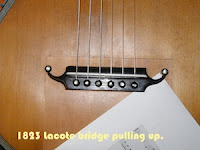Several years ago Brooklyn guitarist Pat Bianculli arranged for me to look at a persistent problem that plagued his 1823 Lacôte. At some time previous to his purchase of the guitar, the area around the bridge had been so badly damaged that it was necessary to graft a new piece of spruce to the soundboard. Unfortunately, the wing on the treble side of the bridge lifted from the soundboard and defied repeated attempts to re-glue it.
 |
| Pasquale Bianculli photo |
As a starting point I removed the bridge and was mildly surprised to see that some of the tension in the soundboard was relieved as the cupping eased slightly. Encouraged, I decided to employ a technique used in lute repair. When bellies are made too thin the area behind the bridge distorts around the one or more of the diagonal fingers bars causing the bridge to lift. Removing the belly and flattening it is one solution, but an extreme one. Removing the bridge and shaping its bottom to fit the wavy contour of the belly is less invasive than separating the belly from the bowl, or the soundboard graft from the guitar, and flattening it.
Since the small troublesome cup was a permanent feature I decided to incorporate it into the fix. I made a thin maple bridge plate, carefully contoured to the underside of the soundboard including allowance for the cupped area and glued it in place using the bridge pin holes as a reference. Then followed the technique of shaping the under-side of the bridge and gluing it in place using the same procedure. Sometime after getting his guitar back Pat wrote and said:"My Lacote continues to play well. The repair you did was spot on and it is sounding wonderful."
While I had the guitar in my shop I took photos and made a working drawing. I have made a handfull of Lacote guitars over the last 10 or 12 years and examined several others in museums so I thought I might make a copy of this one. I was especially attracted to it because it retained its original neck, soundboard frets and low bridge, although neither the bridge nor the peghead are original. I viewed all of this an an exciting possibility and looked forward to having the spare time to build a model.
Which I have done and I am nearly finished! My next post will describe its construction.
All photos by the author except as noted.




No comments:
Post a Comment